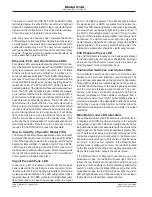
Issue Preliminary 1, October 2022
Model 214A User Guide
Page 20
Studio Technologies, Inc.
Model 214A
ANNOUNCER’S CONSOLE
minimum output level or can be fully muted. The action of
the sidetone function is also configured using STcontroller.
To understand exactly how the level controls on a specific
Model 214A will function requires knowledge of how that
unit has been configured. Please refer to the Configuration
section for details. It may require a bit of study to fully under-
stand how the controls will function. The author would like to
be able to provide a simple explanation. But there are really
five simple explanations, one for each configuration choice!
Each level control has a mechanical step (detent) that is
located at the halfway (50%) position of its rotation range.
This is intended to serve as an aid to Model 214A users. In
an ideal installation, setting the controls to their detent posi-
tion will result in a comfortable headphone output level. The
user, in response to a changing operating environment, can
then move the level controls to get more or less headphone
level as desired. The detent position will always remain as
a useful reference point. To achieve this condition the audio
level on the appropriate Dante receiver (input) channels
will have to be calibrated as required. This is somewhat
counterintuitive to the usual mentality of just providing the
user with whatever level comes up by default. Spending a
few extra minutes “trimming” the levels of the audio channel
can result in much happier, and more-productive, users.
One of the headphone output modes uses control B, locat-
ed in the center of the unit, as a level balance function. In
this case, the detent position will send approximately equal
levels to both the left and right headphone output channels.
This is as one would expect from a “stereo” balance control
such as provided in consumer electronic equipment.
When the headphone minimum level configuration is set to
–40 dB, turning a level control to its fully counterclockwise
position will cause the level of its associated headphone
output channel(s) to become 40 dB below maximum.
This ensures that users will never be fully “isolated” from
potentially important cue signals. In addition, when a control
is set to provide a balance function, turning it to either its
fully clockwise or fully counterclockwise position will cause
the level on the applicable headphone output channel to
be 40 dB below its maximum.
If the headphone minimum level configuration is set for full
mute, turning a level control to its fully counterclockwise
position will cause the level of the associated headphone
output channel(s) to fully mute. In addition, when a control
is configured to provide a balance function, rotating it to
either its fully clockwise or fully counterclockwise position
will cause the level of the applicable channel to fully mute.
The overall level of the headphone output can be config
-
ured as desired for specific applications. In the STcontroller
configuration application this is referred to as the Gain
Range. The default setting, low, is designed so that users
will typically set the rotary controls at approximately 50%
of rotation. The high setting would be applicable in cases
where an extreme headphone output level is required or
the source material that is provided on the Dante receiver
(input) channels is lower than typical.
Sidetone Function Activity
The Model 214A’s sidetone function is used to send
post-microphone-preamplifier audio to the headphone
output as a user confirmation signal. Whether or not the
sidetone function can be active will depend on the con-
figuration of the Headphone Output – Audio Sources and
Routing parameter in the STcontroller software application.
Three of the five available modes enable sidetone. If one
of these three modes is selected, when sidetone audio
will actually be sent to the headphone output will depend
on the configuration of the Headphone Output – Sidetone
parameter in the STcontroller application. The Sidetone
parameter can be configured from among four choices. One
disables sidetone. The other three allow sidetone audio to
be active when the Dante main transmitter (output) channel
is active, to be active when the Dante talkback transmitter
(output) channel is active, or to be active whenever either or
both the Dante main or Dante talkback transmitter (output)
channels are active. Sidetone audio will always be sent to
both the left and right headphone output channels.
USB Interface
A USB type A receptacle and associated status LED is
located on the back panel of the Model 214A. It is labeled
Firmware Update and is used only for updating the unit’s
operating firmware (embedded software). No audio data
of any kind will pass through it. For details, please refer to
the Technical Notes section.
Technical Notes
IP Address Assignment
By default, the Model 214A’s Ethernet interface will attempt
to obtain an IP address and associated network settings
using DHCP (Dynamic Host Configuration Protocol). If
a DHCP server is not detected, an IP address will be
assigned using the link-local protocol. This protocol is
known in the Microsoft
®
world as Automatic Private IP
Addressing (APIPA). It is also sometimes referred to as
auto-IP (PIPPA). Link-local will assign an IP address in the
IPv4 range of 169.254.0.1 to 169.254.255.254. In this way,
multiple Dante-enabled devices will be connected together
and automatically function, whether or not a DHCP server
is active on the LAN. Even two Dante-enabled devices that
are directly interconnected using an RJ45 patch cord will
correctly acquire IP addresses and be able to communicate
and transport audio.
Содержание 214A
Страница 2: ...This page intentionally left blank...






















